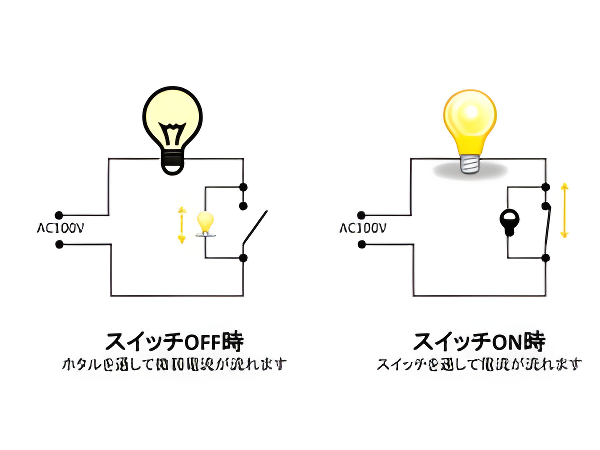The switch that talks back
Walk into a Japanese home on a rainy evening, and you might spot a dim orange glow by the door. That’s no decoration. It’s a pilot switch, quietly letting you know that something’s on—usually a light outside or in a rarely used room. I’ve always appreciated that about Japanese electrical culture. It values small indicators that keep you informed without demanding attention. Pilot switches are a perfect example.

They may seem like a tiny detail in the architecture of a house, but they’ve saved me—and my clients—countless trips into cold hallways to figure out whether a light was left on. Let’s break it down.
What exactly is a pilot switch?
In essence, a pilot switch is a regular wall switch with a built-in indicator light. When the load (a light fixture, typically) is on, the pilot lamp lights up to show you it’s active. In Japan, they’re common in both old and new buildings—especially where the load is out of sight: porch lights, bathroom fans, outdoor floodlights, or hallway fixtures.

The idea is simple: let the switch tell you what the circuit is doing. Unlike smart home apps or expensive automation systems, pilot switches are brutally simple and affordable.
When you work on rural homes with no central panels or monitoring, pilot switches become the quiet communication between your hands and the house.
Illuminated for a reason: why the glow matters
Most Japanese pilot switches glow orange, green, or red when the connected load is on. Some variants reverse this—lighting up when the switch is off, to help you find it in the dark (this is more common in hotels or shared spaces).
This isn’t about aesthetics—it’s function first. An orange glow at the kitchen door means the back alley light is still on. That tiny light saves electricity, reduces unnecessary wear on the bulb, and gives peace of mind.
In old Japanese inns I’ve worked on, I often find pilot switches retrofitted into traditional walls. The contrast between shoji screens and glowing indicators feels like a perfect blend of old and new—silent, respectful, and practical.
The main types you’ll run into
Pilot switches in Japan come in a few common types. Here’s what I’ve installed most frequently:
- Neon pilot switches: The classic type—an orange or red glow when the load is on.
- LED locator/pilot hybrids: Glows faintly when the light is off, and brighter when it’s on.
- Double-pole pilot switches: Used in 3-way or complex circuits, often with ventilation fans.
- Built-in pilot socket switches: Found in commercial kitchens and utility areas.
- Touch-sensitive pilot panels: Rare but appearing in smart homes—digital but still show status.
None of these require a smart system or an app. That’s the beauty.
Japan doesn’t overthink basic infrastructure. A pilot switch doesn’t need to be clever—it just needs to work, and tell you when it is.
How we use them in real-life spaces
I remember wiring a farm cabin near Nagano in 2018. No central lighting system—just solar power, a few LEDs, and a pilot switch for the exterior motion floodlight. That tiny orange glow on the wall told us if the floodlight was stuck on from motion triggers, saving the battery from draining overnight.
In urban apartments, I’ve added pilot switches near breaker boxes to help elderly clients see which zone is drawing power. It’s not just about convenience. In a humid country like Japan, where mold and rot creep fast, you want to know if a fan is running when you’re not around.
I’ve also used them in tool sheds, outhouses, barns, and even chicken coops. If something is far from your main switch, you want the switch to tell you the truth.
Wiring details and common mistakes
Most Japanese pilot switches need a neutral wire and proper grounding, which isn’t always present in older buildings. That’s where DIYers get stuck. I’ve had to rewire entire junctions because the switch had no neutral return path, causing either a permanent glow or complete silence.
Some models are internally wired for hot-side switching, and won’t light up unless installed exactly as intended. That’s why I always bring a test lamp and verify load behavior before finalizing the cover plate.
If a pilot switch isn’t behaving the way it should, don’t blame the switch—blame the assumptions made while wiring it.
And another tip: label the switch plate. I’ve started using small kanji stickers like “外” (outside) or “換気” (ventilation) to help clients know what each switch is talking about.
Light that speaks without noise
Pilot switches are one of those humble technologies that keep the home honest. They don’t beep, buzz, or blink. They just glow. In my work, that’s what I appreciate most—quiet feedback. Whether you’re deep in the forest wiring a hand-built shack, or retrofitting an old post-war apartment in Tokyo, pilot switches are always worth the extra few hundred yen.
If I had to pick one feature I’d carry over from Japanese homes into every project worldwide, it might just be this: let the switch say something back.















